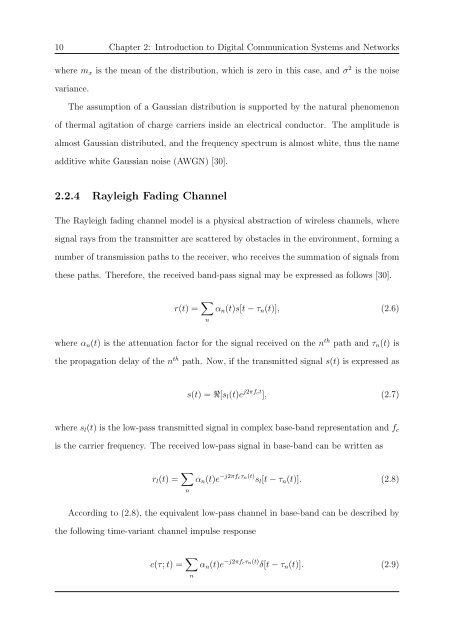Network Coding and Wireless Physical-layer ... - Jacobs University
Network Coding and Wireless Physical-layer ... - Jacobs University
Network Coding and Wireless Physical-layer ... - Jacobs University
You also want an ePaper? Increase the reach of your titles
YUMPU automatically turns print PDFs into web optimized ePapers that Google loves.
10 Chapter 2: Introduction to Digital Communication Systems <strong>and</strong> <strong>Network</strong>s<br />
where m x is the mean of the distribution, which is zero in this case, <strong>and</strong> σ 2 is the noise<br />
variance.<br />
The assumption of a Gaussian distribution is supported by the natural phenomenon<br />
of thermal agitation of charge carriers inside an electrical conductor. The amplitude is<br />
almost Gaussian distributed, <strong>and</strong> the frequency spectrum is almost white, thus the name<br />
additive white Gaussian noise (AWGN) [30].<br />
2.2.4 Rayleigh Fading Channel<br />
The Rayleigh fading channel model is a physical abstraction of wireless channels, where<br />
signal rays from the transmitter are scattered by obstacles in the environment, forming a<br />
number of transmission paths to the receiver, who receives the summation of signals from<br />
these paths. Therefore, the received b<strong>and</strong>-pass signal may be expressed as follows [30].<br />
r(t) = ∑ n<br />
α n (t)s[t − τ n (t)], (2.6)<br />
where α n (t) is the attenuation factor for the signal received on the n th path <strong>and</strong> τ n (t) is<br />
the propagation delay of the n th path. Now, if the transmitted signal s(t) is expressed as<br />
s(t) = R[s l (t)e j2πfct ], (2.7)<br />
where s l (t) is the low-pass transmitted signal in complex base-b<strong>and</strong> representation <strong>and</strong> f c<br />
is the carrier frequency. The received low-pass signal in base-b<strong>and</strong> can be written as<br />
r l (t) = ∑ n<br />
α n (t)e −j2πf cτ n (t) s l [t − τ n (t)]. (2.8)<br />
According to (2.8), the equivalent low-pass channel in base-b<strong>and</strong> can be described by<br />
the following time-variant channel impulse response<br />
c(τ; t) = ∑ n<br />
α n (t)e −j2πf cτ n (t) δ[t − τ n (t)]. (2.9)

















